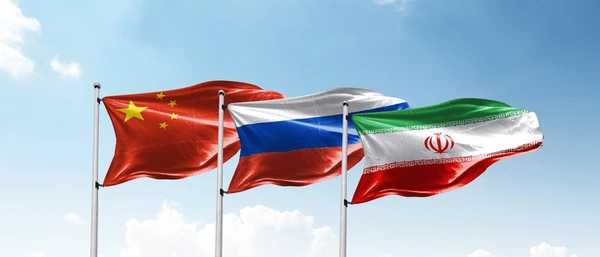
Iran has been forging closer ties with Russia and China since the US’s withdrawal from the Joint Comprehensive Plan of Action (JCPOA), which took place in 2018 under Trump’s administration. However, it took noticeable steps in this direction in 2021 when the more conservative president Ebrahim Raisi came to power. Subsequently, the war in Ukraine and now the Israel-Hamas conflict has brought these three countries even closer together. In particular, Russia and Iran, through the help and support of China, currently represent two main antagonists of the West.
Russia and Iran have long-been resistant to the US-led global order, despite their differences, which seem to be narrowing down. Their converging stand on various regional conflicts including Afghanistan and Syria facilitated the process. It is, however, due to the conflicts in Ukraine and Gaza that the two start to look more like allies. Since the start of the Russian invasion in Ukraine, Iran’s military aid to Russia has dramatically increased. A growing number of Shahed drones are being sold to Russia for use against Ukraine. Furthermore, according to American intelligence, Iran is preparing to ship short-range missiles to Russia, despite the several warnings against doing so. As a result, following the conflict in Ukraine, Iran did not find itself isolated anymore: it entered an alliance of sorts with Russia and, consequently, China, to which it also sells oil.
Such alliance has been strengthened by the conflict in Gaza. Both Russia and Iran would like to see US’s influence in the Middle East challenged, which Iran can do thanks to its proxies. The latter have, in fact, the power to broaden and complicate the ongoing conflict, which to some extent they have done in recent days by targeting ships in the Red Sea and going after US targets. Furthermore, and crucially, the conflict in Gaza sways the West’s attention and resources away from Ukraine, thus weakening Ukrainian resistance and giving Russia an advantage. Although it is maintained that Iran just like Russia do not intend to have a direct confrontation with the US, they are both willing to push towards the limit in order to destabilise the region, each for their own gains. Closer ties with Russia and China also benefit Iran in relation to its nuclear plan which has recently been revived to a worrisome extent. This is so for China and Russia are members of the UN Security Council, thus have the power to veto sanctions.
Despite President Biden’s attempts to reach a new agreement with Iran that would contain its nuclear program, Tehran has accelerated it. In 2022 uranium was enriched to 60% purity, just shy of the 90% needed to produce weapons. There have, however, not been many public talks about this, for realistically the US’s options to take action against Iran, at least through the official channels of the UN Security Council, are very limited. Now, with the conflict in Gaza, and the possibility of a wider conflict looming, the US has even less leverage over Iran. On its part, Iran has created for itself a very efficient safety net that allows it to pursue its interests with little to no impunity. With regard to its proxies, “the axe of resistance”, it maintains to not have operative control over them, which grants it plausible deniability for any of the attacks carried out by them. As much as it may be true, its influence over these groups is undeniable and its power to stir them up give it leverage over the West.
A clear example of how Iran’s proxies can impact the West beyond a military conflict, is the Houthi’s attacks in the Red Sea. The indiscriminate use of heat-seeking missiles poses a significant threat to all vessels. This, in turn, risks impacting global shipping. In fact, some major companies have suspended transit through the Red Sea, thus leading to possible supply-chain delays. The US is relying on American naval presence to defend ships, however, if the attacks were to continue, US officials might consider attacking the Houthis in Yemen. This might increase deterrence but might also lead to a wider conflict that would inevitably cause further disruption. Therefore, whether to launch attacks against Iran’s proxy will have to be carefully evaluated. Again, it is clear how Iran has managed to put the US in a very difficult spot where its options are limited and always potentially inefficient.
To conclude, in recent years Iran has been forging mutually beneficial ties with both Russia and China, thus joining an alliance of sorts against the West, the US in particular. Such partnership has grown from practical, see Iran’s supply of weapons to Russia, to strategic, see how Iran’s ability to destabilise the Middle East greatly benefits Russia. This new power dynamics has benefited Iran both financially and politically, as it now has a chance of becoming a fundamental player on the international stage, besides Russia and China, and not only in its region. Importantly, this alliance has also allowed Iran to revive its nuclear plan with impunity, which grants it a further leverage vis-à-vis the West. As a result, the latter cannot but perceive Iran has a renewed and concrete threat which it will have to address under highly unfavourable circumstances.
By The European Institute for International Law and International Relations















